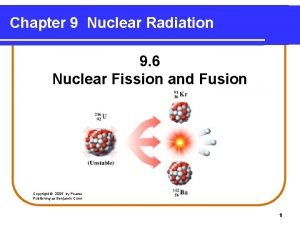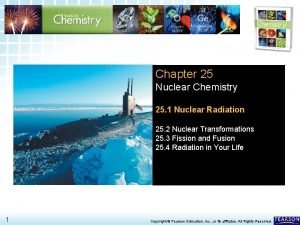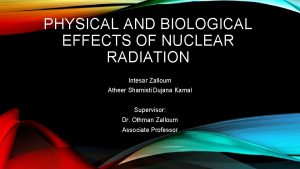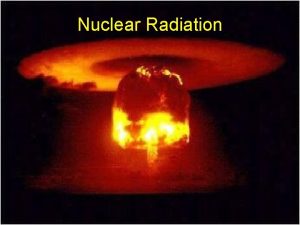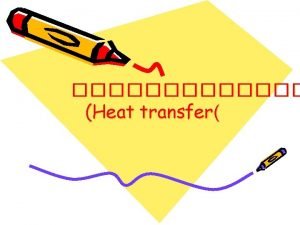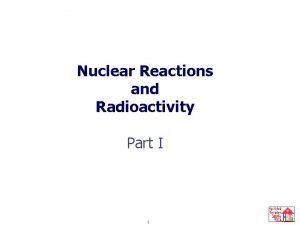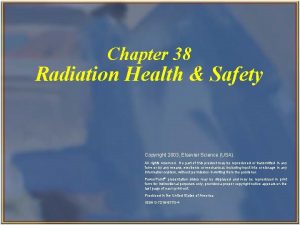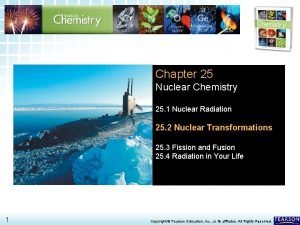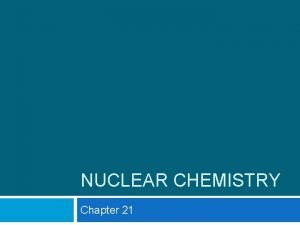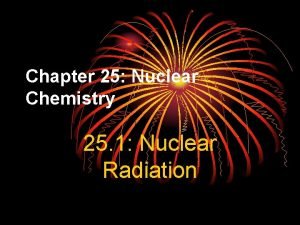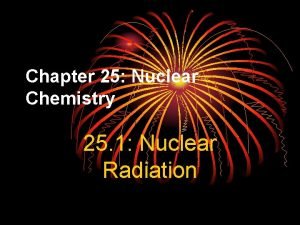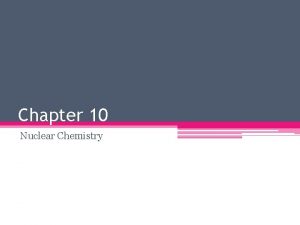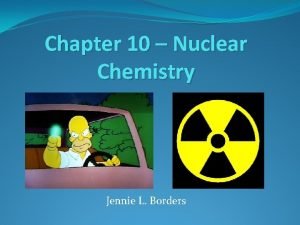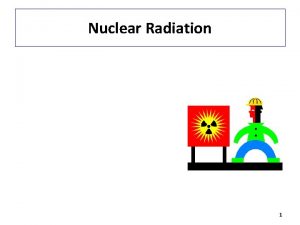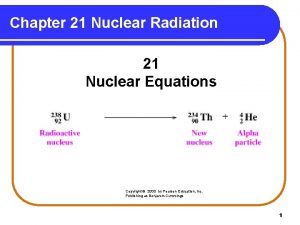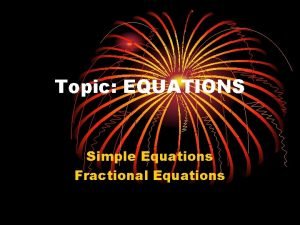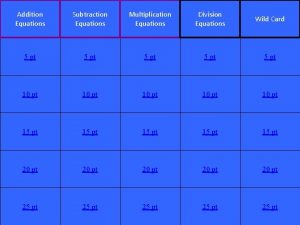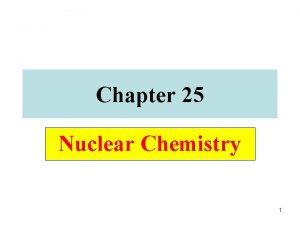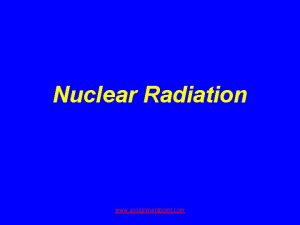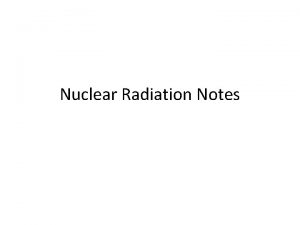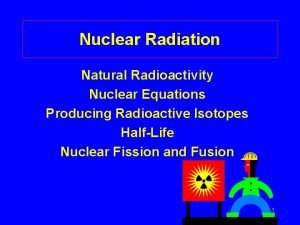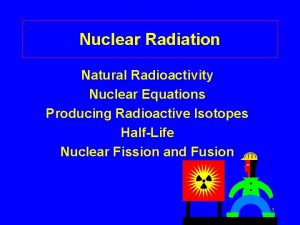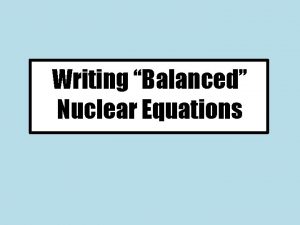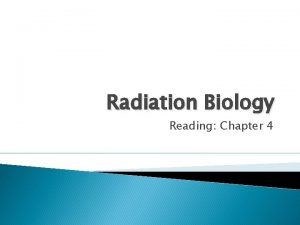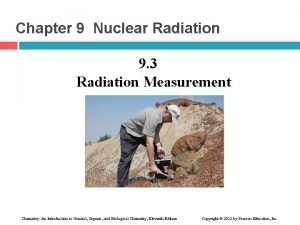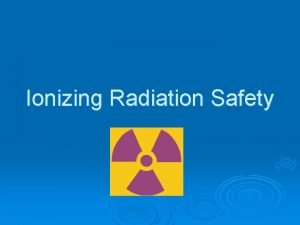Chapter 9 Nuclear Radiation 9 2 Nuclear Equations





















- Slides: 21

Chapter 9 Nuclear Radiation 9. 2 Nuclear Equations Copyright © 2005 by Pearson Education, Inc. Publishing as Benjamin Cummings 1

Alpha Decay When a radioactive nucleus emits an alpha particle, a new nucleus forms that has • a mass number that is 4 less than that of the initial nucleus. • an atomic number that is decreased by 2. 2

Balancing Nuclear Equations In a balanced nuclear equation, the sum of the mass numbers and the sum of the atomic numbers for the nuclei of the reactant and the products must be equal. MASS NUMBERS Total = 251 251 Cf 247 Cm + 4 He 98 Total = 96 2 98 = 98 ATOMIC NUMBERS 3

Guide to Balancing a Nuclear Equation 4

Equation for Alpha Decay Write an equation for the alpha decay of 222 Rn. STEP 1 Write the incomplete equation 222 Rn ? s + 4 He 86 2 STEP 2 Determine the mass number STEP 3 Determine the atomic number 222 – 4 = 218 86 – 2 = STEP 4 Determine the symbol of element STEP 5 Complete the equation 222 Rn 86 218 Po 84 + 4 He 2 84 84 = Po 84 Po 85 At 86 Rn 4 He 2 5

Beta Decay A beta particle • is an electron emitted from the nucleus. • forms when a neutron in the nucleus breaks down. 1 n 0 e + 1 H 0 -1 1 6

Writing An Equation for a Beta Emitter STEP 1 Write an equation for the decay of 42 Potassium, a beta emitter. 42 K new nucleus + 0 e 19 -1 STEP 2 STEP 3 STEP 4 Mass number : (same) Atomic number: 19 + 1 Symbol of element 20 STEP 5 42 K 19 42 Ca 20 + = 42 = 20 = Ca 0 e -1 19 K 20 Ca 7

Learning Check Write the nuclear equation for the beta decay of 60 Co. 8

Solution 60 Co 27 60 Ni 28 + 0 e 1 beta particle 9

Positron Emission In position emission, • a proton is converted to a neutron and a positron. 1 p 1 n + 0 e 1 0 +1 • the mass number of the new nucleus is the same, but the atomic number decreases by 1. 49 Mn 25 24 49 Cr +1 + 0 e 10

Gamma Radiation In gamma radiation • energy is emitted from an unstable nucleus, indicated by m following the mass number. • the mass number and the atomic number of the new nucleus are the same. 99 m. Tc 43 99 Tc 43 + 11

Summary of Types of Radiation Copyright © 2005 by Pearson Education, Inc. Publishing as Benjamin Cummings 12

Summary of Types of Radiation 13

Summary of Changes in Mass and Atomic Numbers TABLE 9. 4 14

Relative Penetration of Radiation 15

Producing Radioactive Isotopes Radioactive isotopes are produced • when a stable nucleus is converted to a radioactive nucleus by bombarding it with a small particle. • in a process called transmutation. 16

Learning Check What radioactive isotope is produced when a neutron bombards 59 Co? 59 Co 27 + 1 n 0 ? + 4 He 2 17

Solution mass numbers 60 = 60 59 Co + 1 n 56 Mn + 4 H e 27 0 27 25 2 = 27 atomic numbers 18

Artificial Transmutation a. Induced Radioactivity 1. Bombarding a normally stable nucleus with high-energy particles can lead to transmutation of one element into another. b. Transuranic Elements 1. Elements heavier than uranium (Z=92), the transuranic elements, do not occur in nature but can be made through artificial transmutation. 19

Irène and Frédéric Joliot-Curie Were the 1 st to produce a radioactive nuclide through artificial transmutation Credit: Corbis 20

Transuranic elements in the periodic table Elements higher than Uranium 92 are transuranic elements 21
 Nuclear fission radiation
Nuclear fission radiation Types of radiation
Types of radiation What is nuclear radiation
What is nuclear radiation Nuclear radiation
Nuclear radiation Lesson 15 nuclear quest nuclear reactions
Lesson 15 nuclear quest nuclear reactions Fisión nuclear vs fision nuclear
Fisión nuclear vs fision nuclear Conduction convection radiation equations
Conduction convection radiation equations Balance nuclear equations
Balance nuclear equations Polar to rectangular equation
Polar to rectangular equation Translating chemical equations
Translating chemical equations List the properties of x radiation chapter 38
List the properties of x radiation chapter 38 12x12x12x12x12x12x12
12x12x12x12x12x12x12 Chapter 25 nuclear chemistry answer key
Chapter 25 nuclear chemistry answer key Chapter 21 review nuclear chemistry
Chapter 21 review nuclear chemistry Nuclear fusion
Nuclear fusion Chapter 25 nuclear chemistry
Chapter 25 nuclear chemistry Chapter 10 nuclear chemistry
Chapter 10 nuclear chemistry Chapter 10 nuclear chemistry
Chapter 10 nuclear chemistry Tube rating chart
Tube rating chart Nhti radiation therapy
Nhti radiation therapy Cancer treatment
Cancer treatment Radiated heat always travels downwards
Radiated heat always travels downwards
